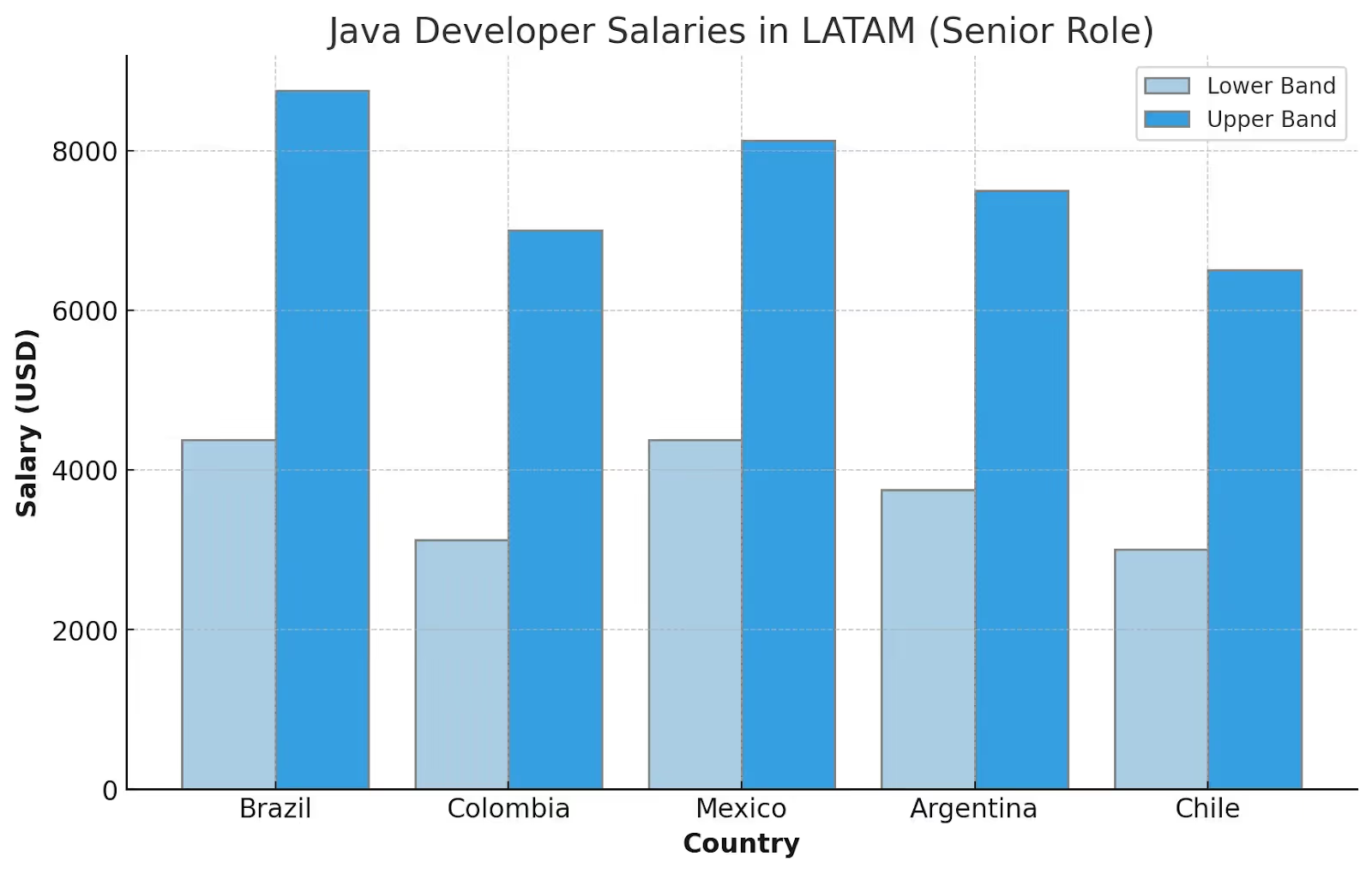If you’re a hiring manager, decision-maker, or recruiter for a tech company in the U.S. or Canada, the process of finding the right development partner can feel overwhelming. Between buzzwords, diverse outsourcing models, and a nearly endless list of providers, it’s easy to get lost. But don't worry—this guide is here to make your journey easier.
Outsourcing Java development in LATAM is emerging as a top choice for companies looking for high-quality, cost-effective, and reliable solutions. LATAM Java developers bring strong technical skills, cultural alignment, and time-zone convenience. Let’s dive in and explore the unique advantages and steps to help you easily outsource Java development.
The Role of Java Development in Latin America
Java development is a critical skill in the technology industry, and Latin America is becoming a major hub for Java talent. The versatility, stability and widespread use of Java in enterprise applications make Java developers essential for web, mobile and backend development projects in sectors such as finance, e-commerce and telecommunications. LATAM is fast becoming the preferred destination for companies looking for skilled Java developers at competitive rates.
Latin American Java developers are increasingly recognized for their mastery of modern Java frameworks and their adaptability to new technologies. Java remains one of the most in-demand skills, with developers in the region often working with frameworks such as Spring, Hibernate and microservices architectures. LATAM's growing Java developer community is supported by technology meetups, bootcamps and communities in major cities, further strengthening the talent pool.
With LATAM's skilled, cost-effective and readily available Java developers, North American companies have an excellent opportunity to expand their technology teams and drive innovation in their projects.
Pros and Cons to Outsource Java Development to LATAM
Outsourcing Java development to LATAM offers unique advantages, but it also comes with some challenges to consider. Here's a look at the pros and cons to help you decide if LATAM is the right choice for your Java project.
Pros of Outsource Java Development to LATAM
- Cost Savings: One of the biggest advantages is cost efficiency. Hiring Java developers in LATAM can be significantly more affordable than hiring locally in the U.S. or Canada.
- Time Zone Alignment: LATAM time zones are very compatible with North America. With only a few hours difference or, in some cases, no difference, real-time communication is easier.
- High-Quality Talent: LATAM developers are highly skilled in Java and related frameworks such as Spring Boot, Hibernate, and microservices architectures. Countries such as Argentina, Brazil, and Mexico produce technology talent with strong backgrounds and high software development standards.
- Cultural Compatibility: Many LATAM countries share similar work cultures and business practices with North America, which facilitates alignment of expectations, timelines and communication styles. English proficiency is also common, especially among IT professionals.
- Quick Scalability: LATAM outsourcing companies offer flexible models that allow you to scale your team up or down depending on project needs without the lengthy hiring processes.

Learn more about How the benefits of staff augmentation can help your business.
Cons of outsourcing Java development to LATAM
- Slightly higher costs compared to Asia: While still cost-effective, LATAM rates may be slightly higher than regions such as Southeast Asia or Eastern Europe.
- Oversight and project management: While offshore outsourcing offers real-time communication, you may need to invest in sound project management practices.
- Geopolitical and economic fluctuations: Some LATAM countries experience economic and political fluctuations, which can affect exchange rates and contract stability.
Exploring Key Latin American Countries for Outsourcing Java Development
Outsourcing Java development to Latin America offers unique advantages, such as lower development costs, skilled talent, and compatible time zones. Let’s take a closer look at key countries in the region—Colombia, Mexico, Argentina, Brazil, and Chile—and explore their developer talent pools, average salaries, and specific benefits for North American companies.
1. Colombia
Salary Range: Colombian Java developers typically earn between $30,000 and $49,500 annually, depending on their expertise level and project requirements.
Time Zone Compatibility: Colombia’s time zone is closely aligned with Eastern Standard Time (EST) in the U.S., with only a one-hour difference during part of the year.
Education and Talent Pool: Colombia has a growing tech industry, with universities producing around 13,000 IT graduates yearly. The country is also home to tech hubs in cities like Bogotá and Medellín, which foster communities around Java and other programming languages.
2. Mexico
Salary Range: In Mexico, Java developers earn around $35,000 to $47,000 per year, offering significant savings compared to U.S. developers, who often command six-figure salaries for similar roles..
Time Zone Compatibility: Mexico offers excellent time zone compatibility, aligning with Central Time (CT) in the U.S.
Education and Talent Pool: Mexico produces over 100,000 tech graduates each year, many of whom specialize in Java development and related fields like web and mobile app development. Top universities, such as the National Autonomous University of Mexico (UNAM) and Tecnológico de Monterrey, ensure high-quality education for future developers.
3. Argentina
Salary Range: Argentine developers earn between $36,000 and $50,500 annually. Compared to U.S. salaries, Argentina offers substantial cost advantages without sacrificing quality.
Time Zone Compatibility: Argentina’s time zone is typically only one to two hours ahead of Eastern Standard Time, which allows for effective communication throughout North American workdays.
Education and Talent Pool: Argentina has a robust tech education system, producing around 115,000 software engineers annually.
4. Brazil
Salary Range: Brazil offers competitive salaries, with Java developers typically earning around $40,000 to $50,500 annually, depending on experience.
Time Zone Compatibility: Brazil shares overlapping hours with both Eastern and Central Time Zones, allowing for real-time collaboration with U.S. teams.
Education and Talent Pool: Brazil has the largest tech talent pool in Latin America, with around 750,000 developers across the country. The Brazilian government has invested significantly in tech education, producing developers who are skilled in Java, Python, and other key technologies.
5. Chile
Salary Range: Chilean Java developers earn an average of $40,000 to $50,000 annually. This is somewhat higher than salaries in other LATAM countries but still considerably lower than in North America.
Time Zone Compatibility: Chile aligns well with Eastern Time in the U.S., only one or two hours ahead, facilitating regular communication during work hours.
Education and Talent Pool: Chile’s tech talent is growing, especially in data science, analytics, and web development. With around 60,000 tech graduates annually, the country is becoming a reliable source of skilled Java developers.
For North American companies, the proximity, cultural compatibility, and cost savings LATAM offers make it an increasingly popular destination for outsourcing Java development. Each country provides a unique mix of skills, time zone alignment, and economic advantages, allowing companies to tailor their outsourcing strategies according to specific project needs.

Explore the complete guide to hiring Latin American developers.
Comparing Nearshore, Offshore, and Onshore Java Development
When outsourcing Java development, it's important to understand the key differences between nearshore, offshore, and onshore options. Here's an in-depth look at these three outsourcing models to help you make an informed choice.
1. Nearshore Outsourcing
Nearshore outsourcing involves working with development teams located in nearby countries, such as LATAM (Latin America) for US and Canadian companies. The main advantage of nearshoring is that it offers overlapping time zones, which facilitates real-time communication. For example, teams in Colombia, Mexico, and Brazil work similar hours to those in North America, which simplifies project coordination.
Cultural Compatibility
LATAM countries also share more cultural and business similarities with North America than more distant regions. In addition, high English proficiency is common in technology hubs in Mexico, Argentina and Colombia, which helps reduce communication barriers.
Cost Efficiency
Java developers in LATAM earn annual salaries ranging from $30,000 to $50,000, a significant savings compared to wages in the U.S., which can easily exceed $100,000 for similar roles.
Ideal For
Nearshore outsourcing is an excellent choice for companies that value real-time communication, cultural compatibility, and moderate cost savings. It is especially useful for agile development teams that require daily or frequent check-ins to maintain momentum and quality.
2. Offshore Outsourcing
Offshore outsourcing typically involves hiring developers in much more distant regions such as Asia (including countries such as India, the Philippines, and Vietnam). The primary attraction of offshore development is cost savings. Asian markets offer some of the most competitive development rates in the world, with salaries often significantly lower than those in LATAM or North America.
Challenges: Time Zone and Communication
Working with teams in Asia means dealing with large time zone differences. For North American companies, this can make real-time collaboration difficult. Schedules may need to be adjusted to accommodate late-night or early-morning meetings, which can slow down projects and cause delays.
Ideal For
Offshore outsourcing works best for projects with well-defined requirements and less need for frequent, real-time interaction. It is a good option for companies that prioritize cost savings over speed.
3. Onshore Outsourcing (Within the U.S. or Canada)
Onshore outsourcing involves hiring development teams within the same country, such as the U.S. or Canada, for North American companies.
Seamless Collaboration
With onshore outsourcing, all team members work on the same (or similar) schedule, making real-time collaboration seamless. In-house outsourcing is especially beneficial for projects that require close collaboration, high levels of creativity, or rapid adaptation to changing requirements.
Higher Costs
The main disadvantage of onshore outsourcing is cost. Due to higher salaries in the U.S. and Canada, this option is the most expensive, with developer salaries often ranging from $80,000 to $150,000 per year, depending on specialization and experience. For startups or companies looking to cut costs, this cost premium can be a limiting factor.
Ideal For
Onshore outsourcing is ideal for mission-critical projects that require hands-on collaboration and quick adjustments based on immediate information. It is often preferred for highly complex or sensitive projects, such as those that require extensive user research or a high degree of customization.
Find out more about Alternatives to Nearshore Software Development.
Step-by-Step Guide to Outsourcing Java Development in LATAM
Step 1: Define Your Java Development Needs
Before contacting LATAM vendors, understand your Java development needs. Are you looking for help with web application development, systems integration or mobile support? Describe the scope, timelines and specific skills required.
Suppose you need a Java team to work on a new e-commerce platform. Identify your key priorities, such as secure payment processing, inventory management and user account functionality. Having a detailed outline will make it easier to find a partner with the necessary expertise.
Step 2: Research LATAM Java Development Providers
Begin your search by identifying reputable Java development providers in Latin America. Look for companies with a proven track record, positive customer testimonials and relevant case studies. Online directories, technology forums and LinkedIn can provide a wealth of information on reputable vendors and customer reviews.
Step 3: Evaluate Technical Expertise and Industry Experience
Not all Java developers are created equal. When outsourcing Java development, it is critical to assess both technical knowledge and interpersonal skills.
Look for a provider with a thorough screening process that includes technical tests to ensure advanced Java skills, as well as English language tests to ensure smooth communication. It is also important to check backgrounds and references, as Teilur Talent does, to ensure reliability and experience. A rigorous selection process will help you find highly skilled Java developers to meet your project needs.
Step 4: Assess Communication and Project Management Capabilities
Clear communication is key to the success of any outsourcing partnership. If you're working with a LATAM team, make sure they can provide regular updates, have structured project management processes and are responsive to your needs. Tools such as Slack, Jira and Trello are commonly used to manage communication and track progress.
Step 5: Compare Pricing Models and Contract Terms
LATAM outsourcing providers often offer flexible pricing models, such as hourly rates, fixed-price contracts, or dedicated team arrangements. Take time to understand the pricing structure that best aligns with your project scope and budget. Fixed-price contracts are ideal for well-defined projects, while hourly rates or dedicated teams offer flexibility for ongoing or complex projects.
If you’re working on an evolving product, opting for a dedicated team model might make sense since you can adjust the workload as your project grows. Ask for a detailed quote and compare it with others to ensure competitive pricing without compromising quality.
Step 6: Evaluate Team Compatibility and Cultural Fit
A successful outsourcing partnership is built on more than just technical skills. Assessing the compatibility and cultural fit between your company and the LATAM team is important. Look for a provider that aligns with your company's values, work culture, and communication style. Make sure the team has experience working with companies in your region and understands your market dynamics.
Evaluate the LATAM team's ability to adapt to your work environment, especially if you manage remote teams. Effective collaboration is often based on shared understanding, time zone overlap, and similar approaches to project management.
Step 7: Build a Long-Term Collaboration Strategy
Once you've found a trusted Java development partner, it’s time to think about a long-term collaboration strategy. Discuss plans for ongoing maintenance, scaling needs, and future enhancements to ensure both parties are aligned on your business goals. Establishing a partnership based on mutual trust and transparency can lead to more effective collaboration and greater project success.
Learn more about Outsourcing tech roles: Criteria for choosing the best agency.
A Transparent Partner for Outsourcing Java Development
When outsourcing Java development, transparency is a game-changer in building trust with remote teams—and Teilur Talent stands out in this regard. Imagine you’re ready to hire a skilled Java developer from LATAM through Teilur Talent. Not only will they provide you with potential salary ranges for top talent in the region, but they’ll also give you clear insights into what constitutes a competitive offer.
Transparent Pricing: A Disruptive Approach
Teilur Talent’s commitment to transparency is a key differentiator in the remote hiring industry. Their transparent rate pricing model is designed around two core principles:
Upfront Clarity on Fees
Teilur Talent ensures that their fees are fully disclosed from the outset. You’ll know exactly how much of your payment goes directly to the developer, as Teilur’s margin never exceeds 20%. By offering detailed information on average salaries in LATAM for specific roles, Teilur Talent allows companies to understand typical rates and make competitive offers that attract and retain high-quality developers.
Hiring a developer with Teilur Talent means you’re working with a partner who values fairness and transparency. This approach not only helps you attract skilled developers but also builds a stronger, more trusting working relationship. For companies looking to scale their Java development capabilities with confidence and budget clarity, Teilur Talent’s model is a powerful asset.
FAQ
What are the benefits of outsourcing development? Outsourcing offers access to specialized skills, cost savings, and flexibility. It lets companies scale resources as needed without the long-term commitment of hiring in-house staff.
Why outsource your IT services? Outsourcing IT services can reduce operational costs, increase efficiency, and provide access to high-quality expertise. It’s a practical way to keep up with tech demands.
Why outsource app development? Outsourcing app development brings in specialized skills, shortens development timelines, and allows businesses to focus on their core operations.
Why are Java developers in demand? Java is a versatile and widely used programming language. Java developers are crucial for backend systems, enterprise applications, and large-scale infrastructure, which makes them highly sought after.
Conclusion
Outsourcing Java development to LATAM can be a transformative choice for companies seeking a balance of quality, affordability, and efficient collaboration. Whether you're a startup looking to scale quickly or an established company looking to optimize resources, LATAM's skilled and diverse talent pool offers high technical standards, cultural compatibility, and competitive rates, making it a top choice for North American companies.
To help you make the best decision, use our cost calculator below to estimate your project’s costs and potential savings. For more details and personalized advice, please contact us.








